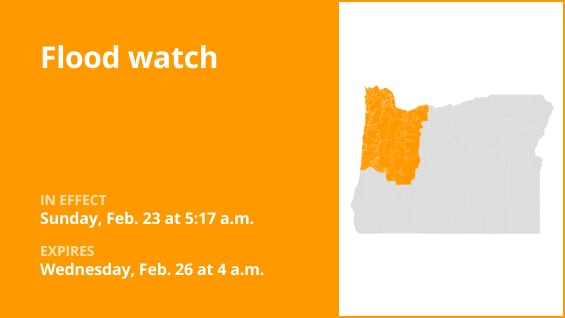The National Weather Service issued an updated flood watch on Sunday at 5:17 a.m. that will remain in effect until Wednesday at 4 a.m. for the following areas: Clatsop County Coast, Tillamook County Coast, Central Coast of Oregon, North Oregon Coast Range Lowlands, Central Oregon Coast Range, Lower Columbia River, Tualatin Valley, West Hills and Chehalem Mountains, Inner Portland Metro, East Portland Metro, Outer Southeast Portland Metro, West Central Willamette Valley, East Central Willamette Valley, Benton County Lowlands, Linn County Lowlands, Lane County Lowlands, West Columbia River Gorge of Oregon above 500 ft, West Columbia River Gorge I-84 Corridor, Upper Hood River Valley, Central Columbia River Gorge I-84 Corridor, Clackamas County Cascade Foothills, Cascade Foothills of Marion and Linn counties, Lane County Cascade Foothills, and North Oregon Cascades.
Commentary from the weather service: “Flooding caused by excessive rainfall remains possible.”
Rivers, creeks, streams, and other low-lying, flood-prone areas may flood as a result of excessive runoff, particularly those that drain the Oregon Coast Range and Willapa Hills. Urban regions and places with inadequate drainage may experience flooding. Due to snowmelt and heavy rains above 7,000 feet, landslides are possible during this time, particularly over the Cascades. The weather service states that there is little chance of debris flows because rainfall rates are not anticipated to reach thresholds over recently burned areas. “You should keep an eye on upcoming forecasts and stay vigilant for any potential flood warnings. Residents who live in flood-prone locations should be ready to act if flooding occurs.
Deciphering advisories, watches, and warnings: Understanding weather alerts
-
Flash flood warning: Take action!
When a flash flood is either approaching or has already occurred, a warning is given. Moving to higher ground right away is essential in places that are prone to flooding. A flash flood is a quick, intense flood that can form in a matter of minutes to hours and even occur in places that aren’t currently receiving any rain.
-
Flood warning: Take action!
When flooding is expected or is happening, a flood warning is issued.
-
Flood advisory: Be aware:
When flooding is not predicted to become severe enough to warrant a warning, a flood advisory is issued. However, it still has the potential to be extremely inconvenient and, if careless, to result in circumstances that endanger life and/or property.
-
Flood watch: Be prepared:
When the weather is conducive to flooding, a flood watch is issued. Flooding is not guaranteed, but it is a possibility.
Weathering the storm: Flood safety guidelines from the weather service
Knowing and adhering to the weather service’s flood safety recommendations can be extremely helpful when camping in low-lying areas or in places that are prone to flooding:
Go to a higher location:
Moving to higher ground is the first line of defense if you live in an area that floods easily or are camping in a low-lying area.
Respect evacuation directives:
Respond quickly to any evacuation orders issued by local authorities. Secure your home by locking it before you leave.
Cut off appliances and utilities:
Disconnect your appliances and utilities if you have the time. By doing this, the possibility of electrical risks during floods is decreased.
Steer clear of waterlogged regions and basements:
Avoid basements or rooms with electrical outlets or cords submerged in water. This lessens the chance of electrical mishaps.
Quick evacuation to keep you safe:
Evacuate right away if you see sparks or hear popping, crackling, buzzing, or snapping sounds. Steer clear of any water that might be electrically charged.
Avoid going on foot in floodwaters:
Even if floodwaters seem shallow, you should never try to go over them. You can be swept off your feet with power by just 6 inches of swift-moving water.
If you’re stuck, look for high ground:
If you find yourself caught by flowing water, get to the highest position you can and call 911 to get help.
Flooding is more likely to occur during times of heavy rainfall, especially in low-lying and flood-prone locations. Driving through any water on the road, even if it appears to be shallow, must be avoided. The weather service claims that 12 inches of flowing water is enough to sweep away the majority of autos. Put your safety first by being aware and ready.
Navigating rainy roads: Safety tips for wet weather
There is a greater chance of floods and dangerous roadways when it rains a lot. The weather service has provided the following advice to help you keep safe during downpours:
Watch out for flooding rivers:
Avoid parking or strolling close to culverts or drainage ditches during periods of intense precipitation, as the swift-moving water can be quite dangerous.
Keep your distances from other vehicles safe:
To keep a safe following distance behind the car in front of you, follow the two-second rule. To account for decreased traction and braking efficiency in heavy weather, give yourself an extra two seconds.
Slow down and drive carefully:
Reduce your speed if it’s raining and the roads are wet. Reduce your speed gently by taking your foot off the accelerator. Never apply the brakes abruptly since this could cause the vehicle to slide.
Pick your lane carefully:
On multilane highways, stay in the middle lanes to reduce the chance of hydroplaning because water tends to pool in the outer lanes.
Visibility is important.
As rain-spattered windows make it more difficult to see other vehicles, turn on your headlights and pay attention to those in blind spots and behind you.
Be cautious on slick roads:
Roads are slickest during the first half-hour of rain because of a combination of rain, oil, and filth. Be especially careful during this time.
Stay a safe distance away from big cars:
Tire spray from big vehicles and buses can make it harder to see. Pass them quickly and safely, and refrain from tailgating.
Be mindful of your wipers:
-
Heavy rain can overload the wiper blades. When visibility is so limited that the edges of the road or other vehicles cannot be seen at a safe distance, it is time to pull over and wait for the rain to ease up. It is best to stop at rest areas or other protected areas.
-
When stopping by the roadside is your only option, position your vehicle as far off the road as possible, ideally beyond guardrails. Keep your headlights on and activate emergency flashers to alert other drivers of your position.
You may greatly lower dangers and protect your health when it rains a lot by adhering to these safety precautions. To ensure a safe and sound voyage, keep yourself updated on weather conditions and follow local authorities’ instructions.
United Robots offers a service called Advance Local Weather Alerts that gathers the most recent information from the National Weather Service using machine learning.










